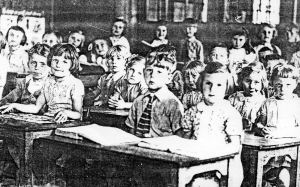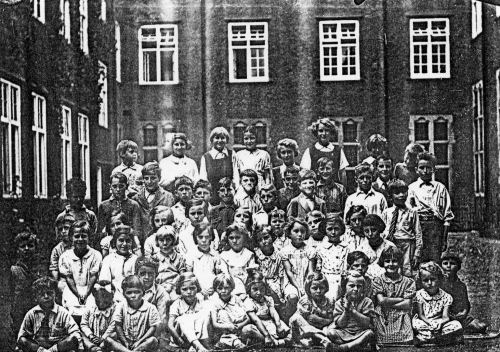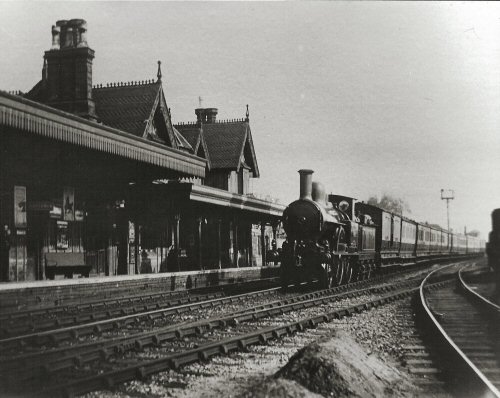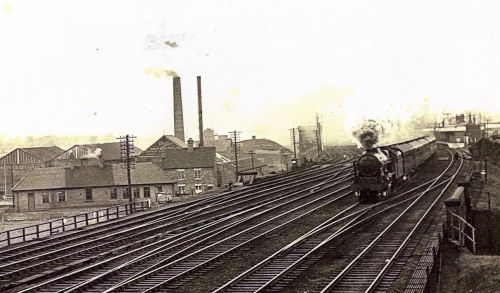| Education A History of Education in Colton The schools Colton children have attended through the ages. Extracts from the log book of St. Mary’s School Many school memories going back to 1864. Find more in the wiki. | Employment Employment in Colton How Colton people have earned a living through the ages. Farming in Colton Farming practices in Colton through the ages. Medieval Glassmaking in and around Colton The evidence we have of this activity. The Mills in Colton An account of the mills that once served Colton. The Canal Comes to Colton Local people employed on the canal and a cruel murder! Steam Comes Through Colton How Colton people found work on the railway. Find more in the wiki . |
| The children of Colton have had the opportunity to go to school since 1764 when the first school was established in the village. Endowments by local Colton people enabled the present school to be built in 1863 and education has flourished here ever since. Over the centuries Colton people have been employed in many trades and crafts such as glass making, brick making, shoe making, tanning as well as the rural industries surrounding the farming that has always been the main employment of this community until more recent times times. There is more information about the school on the wiki. | Extracts from the School Log Book%202.jpg) St.Mary’s school log book makes fascinating reading. Begun in 1864 when the new school opened its doors, the various head teachers have recorded events of local and national importance and how they have affected Colton schoolchildren. |
A History of Education in Colton
%202.jpg) St. Mary’s school Colton in the 19th. Century – click here to see the ‘school log’! | The first school in Colton goes back over 200 years to 1764. In that year the people of the village subscribed towards a school for 20 poor children from the parish to be taught to read, to write, to keep accounts and to know the Church of England catechism. Pupils were provided with books, paper quills and ink, only if their parents could not afford to buy them. In 1821 John Spencer a local farmer in remembrance of his brother, gave another £500 for another 20 poor children to go to the school. |
The school was held in a cottage in the village that still remains today. The master and his son taught the boys, his wife and daughter taught the girls. The girls were also taught to sew and knit.
Another school had been founded for poor village children some time around 1818. The two schools gradually began to work together and by 1851 one was a boys school and the other a girls school. In 1862 it was decided to build a single new school- St. Mary’s; on a site given by the owner of Colton Manor, Mr. Horsfall and funded by the Webb Trust. Parents were charged two pence a week for their first child to go and a penny for each of their other children This Trust also built the schoolmaster’s house, the present Elm Cottage. This school would take any Colton child from the age of 2. At the age of 11 they were transferred to Colwich until after the war when they transferred to Secondary schools in Rugeley.
The school remains in the same building today but with extensions and improvements.
The Census records for the 1841 also record a private school for 18 boys being run at Colton House. It appears to have only existed for a few years and little is known about it as yet.
| In World War II children from St. Saviours, Westgate on Sea, were evacuated to Colton and went to St. Mary’s school. Here is an account of one of these evacuees:-Tony Atkinson now lives in Surrey but was only five years old when he came as an evacuee to Colton. Here he is in the centre of the picture at his school in Westgate on Sea. |  Evacuee photo by kind permission of Tony Atkinson. |
“The evacuation came upon us suddenly. My parents may have had a little advanced notice, but I only remember being at school one day and being lined up with all the other children on the railway platform next. Details are vague: a cardboard lapel label; a gas mask in a box an a very few belongings……The journey took us via Lichfield to Colton and St. Mary’s school. At the school we trundeled into the hall …..Women from the village appeared, and one by one the other children were singled out and taken away, until just two or three of us remained, and then a kindly lady came and ledme away to her home which was to be my home for the next three years.”
Were you one of these evacuees to Colton? Please get in touch if you were.
Extracts From The Log Book of St. Mary’s School
The log book was kept by the head teacher of the school and recorded various events through the school year. We have selected some extracts that might be of interest!
 | 5th Sept 1870 Opened school. Only 24 present the rest absent on various work such as Threshing, cow and pig tending, nursing younger children, minding the house etc. 3rd. June 1873 Rugeley horse fair prevented many who had to come from that direction being here owing to the number of horses on the road. |
3rd. June 1895 School closed for another two weeks on account of the measles epidemic. The school is being thoroughly cleaned. The old well is closed up and a new one is being sunk.
15th. January 1914 The elder children are now leaving school as soon as they can get away. There is a great demand for domestic servants and the girls are spoken for long before they are 13 years of age. The boys are wanted on the farms as many men have enlisted for the War.
19th. October 1917 The children have subscribed 16 shillings towards comforts for the wounded soldiers at Ravenhill hospital, Rugeley. More than a ton of chestnuts have also been gathered for the war effort.
30th. October 1923 In the afternoon the school started at 1 o clock and closed at 3.15 p.m. on account of a circus visiting the village.
29th July 1930 Britain’s newest airship R100 went over Colton at 6.a.m. on its voyage to Montreal. Many children got up early to see it.
14th.September 1936 Water laid on for the first time. Two taps, one in the cloakroom at the side of the north room and one in the cloakroom for the girls.
3rd. September 1939, Sunday War was declared on Germany because Hitler would not withdraw his troops from Poland. Head teacher attended meeting at Lichfield about arrangements for the children to be evacuated from areas likely to be bombed.
26th.& 29th January 1940 A terrific blizzard started this afternoon….the snow is about 3 feet. Deep. …Soldiers billeted at Colton House helped clear snow off the railway. Colton road was impassable to traffic for 10 days….There was a shortage of coal, food was scarce, especially meat….School did not reopen until 12th. February
 This picture was kindly sent to us by Tony Atkinson, one of the evacuees. This is the class of schoolchildren that came to Colton taken outside their school at Westgate on Sea. | 2nd. June 1940 Evacuees from Westgate on Sea , Kent, detrained at Lichfield and went by bus to Frog Lane School there for medical inspection. Afterwards they came on to Colton by bus. They arrived at 8.30. p.m. and were received by the Head Teacher supported by his wife and others of the Parish. By 10p.m. all the children wee billeted. 4th. June 1940 68 evacuees from St. Saviour’s C.E. School at Westgate and their teachers all attended this school. The two schools were kept separate under their own teachers. |
25th. November 1940 12 delayed action bombs fell in Colton parish on Friday evening….None has exploded yet.
29th. August 1944 School reopened. 5 official new evacuees from Harrow and Wembley and one private evacuee from Worcester Park. These have all come on account of the flying bomb menace in London.
21st. December 1946 The first school Christmas party since 1938.
Employment in Colton
Colton is a small village set in the rural Staffordshire landscape. For many centuries the two manorial Lords who owned the majority of the land in and around Colton would have employed the majority of residents in Colton. The only other hints that we have of possible earlier employment for villagers other than farm labouring duties, are that we know there were three mills in Colton so there must have been millers. We also know that there was a thriving market in the Middle Ages so there must have been people peddling wares. We also know that there was a very productive glass industry around the area in the Middle Ages and it is possible that some Colton men worked in this.
Our most productive source of information about employment for villagers comes from the Census records begun at the beginning of the 19th. Century although some information can also be gleaned from the Parish records of births and marriages.
%202.jpg) Picture courtesy of June Meddings | There were a few shops in the village in later years and certainly ale houses. There were other businesses in the village as well such as a corn merchant at the Malt House, a couple of slaughter houses and a blacksmiths. The last butchers shop was in front of the pub now called the Greyhound and closed its doors finally between the wars. |
Colton is situated about a mile away from the small town of Rugeley and therefore a lot of those not employed on the farms worked in Rugeley. As with the whole of England lots of the women in the Parish were employed in service either in the village or in nearby Rugeley. A Colton girl, Eliza Tharm, worked in service for Rugeley’s infamous Dr. Palmer the poisoner!
Both a railway and a canal went through the parish boundaries of Colton and the census records that a number of locals worked on these. The railway employees increase as the 19th Century progresses reflecting how much the railways were being used. Rugeley had quite a big tanning works and Colton people are seen to be working there well into the first quarter of the 20th. Century.
A number of shoe makers and tailors are also shown to be living in Colton and could again reflect the leather and tanning that went on in Rugeley. Whether these were outworkers working from home is not known. Brick workers also feature throughout the 19th. Century and could reflect that the whole area around this part of Staffordshire had many little brickworks making bricks out of the marl found geologically here in this area.
Again from the census records, actually in Colton itself we know that over time there was a Maltser, a tea merchant, two slaughterhouses, a blacksmiths and a couple of publicans running the two pubs in the village. We know that there were a small number of shops including butchers. The last shop, our village post office, closed at the very end of the 20th century.
After the First World War the Rugeley area saw the development of the coalmining industry and until the last mine closed down in the 1980’s a number of men living in Colton earned their living in these pits. Two or three of them lost their lives in mining accidents.
As with everywhere else people mainly travel some distance to work nowadays but there are still just a handful that earn their living in the village itself like the two village publicans!
Farming in Colton
%202.jpg) (Picture courtesy of Joan Anslow from Local history Source Book on Colton.) (Picture courtesy of Joan Anslow from Local history Source Book on Colton.) | Colton lies on top of a bed of Kauper Marl which is a rich clay soil. That means it is highly fertile for growing crops. Marl was used as a top dressing and many generations have exploited this fact.Colton all through its history has been a farming community. There are still signs of farming activities spanning hundreds of years in and around the village. Some of the hedgerows follow the edges of ancient fields. Until very recently ridges and furrows were visible in some of the fields in the village. Many of the field names refer to what may have gone on within those fields such as Eye Meadow Gap (water meadow) , Coney (rabbit) Greave, Little Mill Ditch etc. Quite a few of the Colton Tithe Books from the 18th. Century onwards still exist and an examination of these shows the sorts of crops and livestock that were paid to the Rector as tithes.The Parish tithe barn stood next to the oldest Rectory and was converted to a coach house in 1875.An indication of the sorts of crops that were being grown can be ascertained from a number of records that have survived but in particular in the 19th. Century Tithe map and accompanying records. This was made for the village in 1847. It would appear from all of these sources that the fields around Colton have been used in the main for arable farming and sheep farming. The fields have supported the growth of wheat, rye and oats as well as clover as fodder for animals.Grazing of sheep went on in and around Colton also as a major activity as in so many parts of the country.Nowadays the fields are in use for crops such as potatoes for the chip industry and rape for the cooking oil industry. There is very little animal farming. |
Medieval Glassmaking in and around Colton
The fact that there were glass furnaces producing high quality glass in the late medieval period in the vicinity is well documented. Much of this activity took place on land belonging to the Bagot family from Blithfield. Most of the glass furnaces were in Bagots Wood but we also know that there were furnaces on Cannock Chase near Wolseley Bridges. There was a plentiful supply of wood on the Chase and also in Bagots wood for use in the furnaces
We also know that Flemish glass makers came over to work at these furnaces and it appears that much of the glass they helped produce was of high quality. We know that some of it was used to glaze windows in York Minster.
In the last few years a farmer in the Parish of Colton discovered one of these furnaces in a field on his land and a survey by Keele University has shown this too belonged to this period. All around the area there must have been a network of small furnaces involved in glass production. A lane in the next Parish to Colton commemorates this very skilled trade in its name-‘Glass Lane’ and is reputed to be where one of the Flemish glassworkers lived with his family.
For further info on the Glassmaking Industry in Bagot’s Park-
“Glassmaking in Bagot’s Park, Staffs. in the 16th. Century by D. Crossley. University of Sheffield. Copy in William Salt Library Staffs.
The Mills at Colton
%202.jpg) | The first evidence we have of a mill at Colton is in the Domesday Book. It is entered under the holding of Robert of Stafford and is said to be paying 12 pence, quite a lot of money in 1086 when Domesday was compiled. This mill existed for hundreds of years and provided a good source of income for the Lord of Colton Manor. It was situated close to the present day bridge over the River Trent on the B5013 road to Rugeley and was powered by water from the River Trent. We hear about this mill again in documents that have survived from 1570. (Staffordshire Archives). One document records a dispute over a right of way next to the mill between the then Lords of Colton Manor-the Gresleys and Lord Paget who owned most of the land on the other side of the Trent in Rugeley. Tenants of the Gresleys chained and guarded the bridge with weapons! |
Through most of its history this mill ground corn but in 1834 it is recorded as grinding flint. Rugeley saw the the development of the sanitary ware trade in the 19th. Century and flint was used in the process. The mill was probably supplying this industry. We have census records of the families who were the millers in the latter half of the 19th. Century. Also in the 19th. Century it is recorded as manufacturing plaster and cement. At the end of its life the site was owned by a company producing oxide of iron and other colours for use in paint and some Colton residents worked there.
Picture courtesy of J. Anslow. Local History Source Book.
A second mill at Colton is recorded in old documents as far back as 1383 at Hamley. We know it was a windmill again for the grinding of corn. The only hints to its exact location now are field names such asWilmor, Mill Ditch and Mill Ditch meadow.
There was almost certainly a third corn windmill at one time but we have little idea as to its location.
The Canal Comes through Colton
A canal was built through Colton in the late 18th. Century by James Brindley and some local Colton people found employment on or around it. A wharf was built along the canal where it passed through the Bellamour Estate..
On the 14th. June 1839 the stretch of canal between Colton and Rugeley was the scene of a bloody murder. The body of a young woman called Christina Collins was found floating in the canal where it went through Colton on towards Rugeley. She had been raped and brutally murdered. It emerged that she had been travelling from Liverpool on the canal system intending to join her husband in London for the cost of £1. Eventually two bargees were arrested for her murder. They were tried and subsequently hung. When she was dragged out of the canal her body was carried up some steps and they came to be known locally as ‘The Bloody Steps’.
Nowadays the canal has many pleasure boats passing through Colton. If you are on one, stop off and come and take a look at Colton!
Steam Comes to Colton
 | The Act of Parliament for the construction of the ‘Trent Valley Railway’ was passed in July 1845. Sir Robert Peel M.P. was the chief promoter and cut the first sod at Tamworth in November 1845. The engineer was Robert Stephenson (son of George) and his assistant was George Bidden. The contractor was Thomas Brassey. The line partially opened early in 1847and by December 1847 was fully open from Rugby to Stafford. At this time all the railway companies in the country adopted Greenwich Mean Time. The land owners in Colton gave their full support for the construction of the line. The station built in Colton Parish was for many years known in timetables as Rugeley Junction. |
The line to Walsall opened in November 1859. Eventually to prevent confusion with Rugeley’s station on the Walsall line, the station at Colton became Rugeley Trent Valley in April 1917.
During World War I the station was frequently used by troops who would march to or from camps on Cannock Chase. R.A.F. personnel also used it in World War II to get to their camp at Brindley Heath. Many Colton residents used it to get to and from work and also some youngsters to get to school. Some Colton residents found work both at the station in the large goods department and on the trains.
 | The station building was taken down in 1972 when the station became unstaffed. It is still on the main London line and although the service to Walsall and Stafford was for some years axed, it was restored in the 1990’s due to public pressure. Note the colour works in the background. With acknowledgement to the Bradbury family for supplying research information and pictures. |